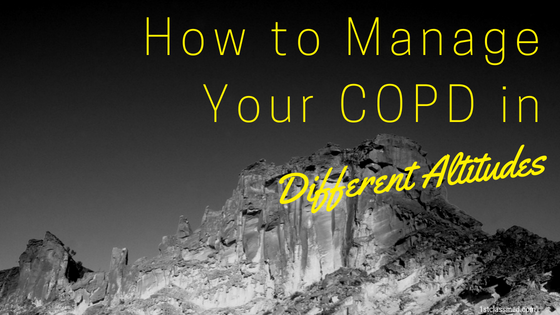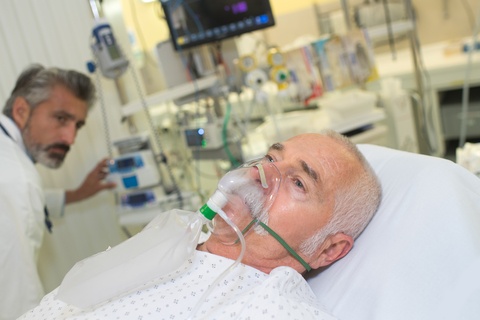
Chronic Obstructive Pulmonary Disease, or COPD, is a lung disease that covers a handful of diseases.
Both emphysema and chronic bronchitis are considered COPD, and have similar symptoms, that includes a difficulty when breathing and coughing.
COPD also can cause exacerbations, which is when some of your symptoms can get worse and last for a few days.
Those with COPD are at a higher risk of getting lung cancer and heart disease, making it vital to quit smoking right away.
How Altitude Affects Breathing:
Traveling with COPD can be difficult, as the altitude can trigger an exacerbation, making it hard to enjoy the remainder of your trip.
Higher altitudes have less oxygen, which can make it hard to breathe, and even harder for those with a respiratory disease.
To understand why higher altitudes have less oxygen, you need to first understand the atmosphere.

At sea level there is the highest level of oxygen, and as you move higher into the sky, the air becomes less compressed and becomes thinner.
Not only does a higher altitude have a thinner amount of oxygen, but also nitrogen and carbon dioxide.
Being in a higher altitude for too long can lead to acute altitude sickness, which can bring on the feelings of nausea, fatigue and headaches.
High altitude pulmonary edema (HAPE) can occur a few days after exposure to a higher altitude (roughly 8,200 feet above sea level and higher), which can cause excess fluid in the lungs and breathlessness.
HAPE can make your COPD even worse, as many of the symptoms can affect the lungs and cause a flare up.
High altitude cerebral edema (HACE) can be life threatening, as it can cause a buildup of fluid in the brain.
HACE occurs in roughly 1% of individuals who ascend about 9,800 feet above sea-level.
Reverse altitude sickness (or high altitude de-acclimatization) can occur when you are exposed to a high altitude for a long period of time, and then return to low altitude.
Normally it requires you to be at 11,000 feet above sea level or higher before descending to a low altitude.
A lot of symptoms can go unnoticed by those who have descended, but others can have some observed symptoms.
Some symptoms can include drowsiness, lower limb swelling, slow reflexes and poor dexterity (moving small muscles, many in the hands and fingers).
More serious symptoms can be memory loss, coughing, chest tightness and unresponsiveness.
Many symptoms for high altitude sickness and for “reverse” altitude sickness can have similar affects as COPD and other respiratory diseases, making it a more amplified feeling.
If you feel the symptoms while at a higher altitude, it can be best to go back down to an altitude you are comfortable with.
Staying at a higher altitude after feeling altitude sickness symptoms can begin to affect the lungs, heart and nervous system, inducing symptoms such as confusion, fainting, or chest tightness.
Supplemental Oxygen While Traveling:
Depending on where you are traveling, there may be a need for supplemental oxygen.
Higher altitudes may require the oxygen supply, as being closer to sea level will have a higher concentration of oxygen and you will not need supplemental O2 if you don’t on a day basis.

If you are already on O2, it can make your traveling a bit easier, as you will have oxygen no matter where you are traveling.
On an airplane or up in the mountains, you will make it easier on your COPD and it can help any symptoms from a severe flare up.
It is important to bring your O2 prescription with you in order to prevent any delays during your travels.
Talking with your doctor about your travels and discussing what you may need and any other information for your trip, can be useful.
Living in High Altitudes:
Living in a high altitude can be hard for those with COPD, as a lower concentration of air can make it much harder to breathe and go about your day to day agenda.
A town or city that is closer to sea level can make it easier on your lungs to breathe and do everyday activities.
Relocating to a lower altitude can be a beneficial decision for your COPD, as high altitudes can lower the quality of life for you.
Growing up in a higher altitude can be beneficial to your health, as the altitude can teach your body to adapt in a positive way.
The higher altitude can help your body become acclimated when you live there for a long period of time, as your lungs can become larger and your body can produce more red blood cells to help the lungs oxygenate the blood.
Those in the highest cities in the U.S. have a lower change of dying of heart disease, the have higher vitamin D production, a longer life span and improved muscular performance.
Though you may be used to the altitude, it can be hard on your lungs to stay in a high altitude location after a respiratory disease diagnosis.
Even with fresh air, if you live close enough to a city or developing area, the construction debris can make it hard on your lungs.
It can also be hard to move to a high altitude location after you are diagnosed with COPD or another respiratory disease.
It is possible to live in a higher altitude but working with your medical team can be a huge factor in the success of your health.
It is important to speak with your doctor about relocation and discuss the best option for you and the best location for you.

No matter where you chose to live, it can have a large impact on your health and it is important to see if where you are living is causing harm to your overall health.
There is also the importance of understanding different forms of altitude sickness and the affects on your body.
You also need to prepare for any travel when changing altitudes, as you may need oxygen for any trip you go on depending on the location.
Many who live in a higher altitude do not noticed a difference when diagnosed with a respiratory disease, as they are comfortable with the altitude.
It is important to speak with your medical team about any travel or relocation plans and make a decision based on your current health status.



